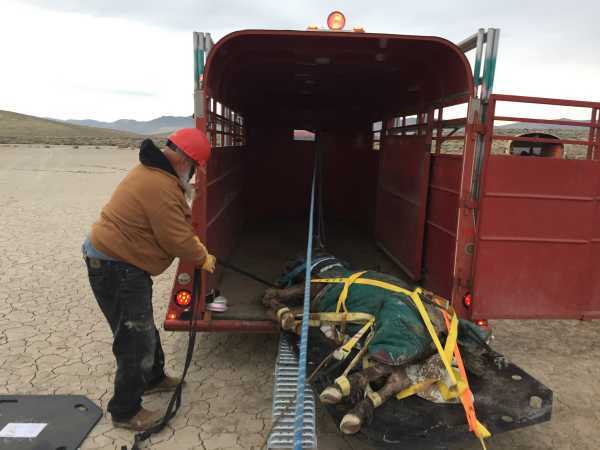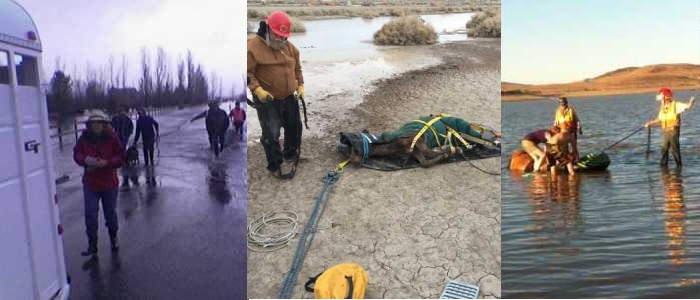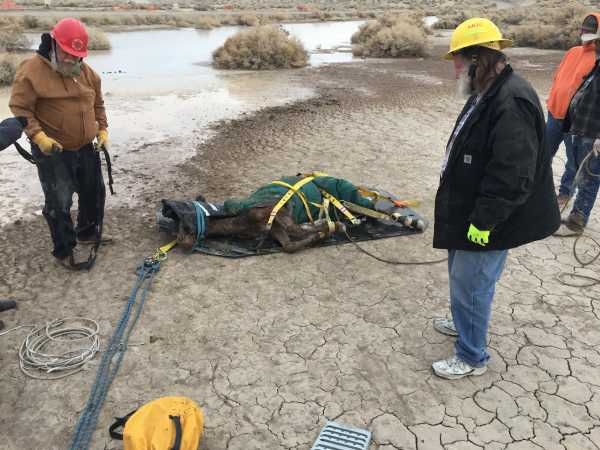|
This information sheet is primarily intended for persons associated with or working with the LRTC Emergency Response Team, however the information may be useful to other groups or private individuals who may wish to similarly equip their own technical large animal rescue team.
Rescuing horses from deep water or ice requires careful size-up of the incident and thoughtful evaluation as to whether the risks involved are worth the likely reward. Ice can be particularly treacherous given the combination of slippery surfaces, the potential for the ice to break further when placed under stress, and the difficulty involved in getting a large animal onto the ice in order to bring it to shore. Additionally, a large animal that has been in icy water for a considerable amount of time could likely suffer extreme hypothermia whereupon long-term survivability could be unlikely.

Deep water ice rescues warrant specific technical expertise and equipment. Most likely a channel will have to be cut in the ice using a chainsaw or rescue saw and the animals led through the channel to shore. Proper protective gear, specialized equipment and appropriate procedures are critical in these events.
This feature will discuss more generic shallow water ice rescues that are most commonly encountered following mild stretches of weather when winter rainwater fills "bowls" or other depressions that then freezes over when cold weather returns. In these instances, animals may break through, and although the water is not very deep, they cannot get sufficient traction to self-extricate.
Water does not have to be very deep to strand a large animal.
The disturbed ice around the hole shows the animal's efforts to self-extricate.
Notice the ice starting to crack under the pressure of the animal's attempts and rescue activity.

- Resolve the problem.
- Don't become part of the problem.
(Some of these protocols are specific to LRTC's team.)
- Respond with the closest TLAR Rescue Unit, the Special Operations Support (SOS) Unit and a transport trailer.
- Respond with the Incident Support Unit in case rehab may be required.
- Carefully evaluate the scene, ice thickness, water depth, distance to shore, etc., before developing a rescue plan.
- Designate a Safety Officer before rescue efforts begin.
- Have all rescuers working near or on the ice wear appropriate PPE and tag lines.
- Deploy ground padding as may be appropriate (plywood pads, slip sheets, ladder, etc.)
- The animal(s) may not be ambulatory. Stage the Rescue Glide for use if potentially needed.
- Roll the animal onto the Rescue Glide and "sled" the animal to shore, if practical.
- Unless the rescued animal is active and can move with coordination and purpose, hypothermia is likely a serious veterinary emergency. Provide for professional veterinary follow-up.
- Make a practical decision as to whether to humanely euthanize the animal or attempt veterinary care.
- Blanket the animal if it is not ambulatory, but avoid rubbing the skin or extremities.
- If the animal is not ambulatory, consider the incident a "load and go" operation.
- Have the loading ramps and Z-rig assembled and ready to use by the time the animal is packaged.
- If the animal has to be hauled out using a line, a Z-Rig with an appropriate anchor provides more control than using a winch.
- Follow the plan, but adjust as real time conditions warrant. Make sure all rescuers are aware of any changes in tactics.
- Be watchful and address any cold exposure issues that rescuers may experience.

|







